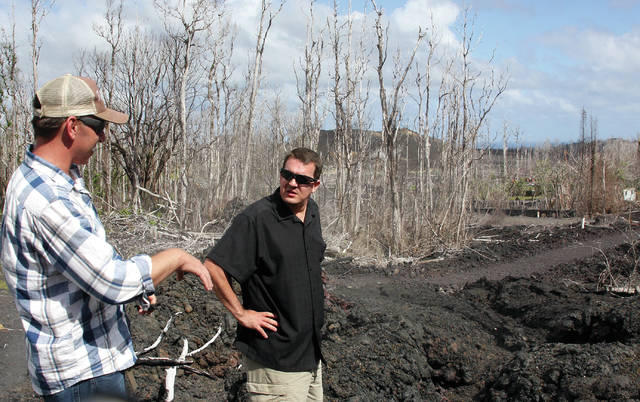Leilani residents adjust to visitors, eruption recovery

Life in Leilani Estates may never be the same again after residents fled fissures that erupted underneath their homes and streets starting last May.
Life in Leilani Estates may never be the same again after residents fled fissures that erupted underneath their homes and streets starting last May.
But with the volcanic vents quiet for more than three months, and a checkpoint that controlled access now removed, what remains of the lower Puna subdivision appears to slowly be getting put back together one house at a time.
ADVERTISING
The signs of disaster are far from gone. Even away from the flow field and the massive fissure 8, some properties remain split by cracks that continue to steam, and a dead zone of vegetation exists downwind of the eruption.
Still, signs of renewal can be seen as small plants start to grow once again, even inside volcanic cracks, and returning homeowners clean their roofs of tephra and other volcanic debris.
Jenny and Mark Bishop returned to their home Tuesday after getting electricity reconnected.
Lava stopped only a few feet from their house, and their property looks out along the flow field and fissure 8.
“It was a tropical forest and now it’s a moonscape,” remarked Mark Bishop.
The vantage point wasn’t lost on some. Jenny Bishop said people broke into their home to watch the fissure erupt while they were gone.
The doors and windows were left open, allowing Pele’s hair and other debris to cover the inside of their home.
But she said it feels good to be back home. As a bonus, they now have views of the ocean and Maunakea.
“We’re fortunate,” Jenny Bishop said. “It’s mixed feelings. Many of our friends and neighbors have lost their homes.”
The four-month-long eruption destroyed more than 700 homes, including 253 in Leilani, and covered more than 13 square miles, before ending Sept. 5.
Mark Bishop said what’s left of Leilani has become more tight knit than before.
But the eruption, which destroyed most of the lower half of the subdivision, has also left many with anxiety and stress that hasn’t gone away, said Dane DuPont, a Leilani resident who documented the eruption for the Facebook group Hawaii Tracker.
“There’s a lot of pent-up frustration right now,” he said.
“I think it’s going to calm down eventually.”
The addition of visitors wanting a look of fissures and flow field may not help for some.
Jenny Bishop said she sees some vehicles stop at her street, which now dead ends at the flow field, to catch a look. She said she asks that they be respectful of the residents.
“Take a picture and leave nothing else,” Jenny Bishop said.
Heath Dalton, who lost his home, was keeping an eye out for people trespassing near his property at Kupono Street.
He said Friday and Saturday wasn’t so bad, though he had several confrontations the day before when the checkpoint came down. Just sitting along the side of the road is enough for some cars to turn around.
“You guys can take all the pictures you want,” Dalton said he tells those who stop, “just don’t trespass on private property.”
Fissure 9 opened up along his property, turning a lush green lot into smoldering rocks.
Dalton said he plans to keep his family on Hawaii Island but won’t rebuild in Leilani.
“I gambled and I lost,” he said. “I won’t take that chance again.”
Being overrun by visitors trying to see the volcanic features has been a concern of the Leilani Estates Community Association, which is one of the reasons it is suing the county for control of Leilani Avenue. The road is the only public street in the subdivision and now dead ends near fissure 8.
Early in the afternoon Saturday, five cars were seen parked alongside the road near the fissure, with some people ignoring warning signs and walking onto the flow field. As cars left, others would arrive.
Jay Turkovsky, president of the association, said that’s just a start, and he’s expecting the flow of visitors to pick up.
He noted some visitors that he’s come across are actually on their way to Pohoiki but were misdirected by their car navigation systems. Residents are doing their best to direct them to Isaac Hale Beach Park or the intersection of Highway 132 and Pohoiki Road, where the flow field and fissure 8 can be seen.
Turkovsky finished Saturday installing signs declaring roads that connect with Leilani Avenue to be private, but he was concerned they might be too small to get drivers’ attention. The subdivision remains restricted to residents under the county’s disaster declaration.
One of the main concerns is people injuring themselves on the flow field, which covers private property, and suing the owner or association. There’s also worry about empty homes being broken into or people squatting inside them.
He estimates at least six to 12 homes have squatters living in them, and burglaries continue to be a problem.
Turkovsky said the association lost a request for a temporary restraining order to prevent the county from removing its checkpoint at Leilani Avenue and Highway 130, but who should control the street is still a matter to be resolved by the suit in federal court.
The association’s goal is to install a gate to control access.
Not all Leilani residents are for the idea.
Michael Brant said that would change the character of the neighborhood.
“You’re making yourselves into outsiders,” he said. “It will feel like you’re not part of the area.”
Turkovsky said the associating is mailing ballots to residents to ask them to vote on the idea.
Email Tom Callis at tcallis@hawaiitribune-herald.com.


